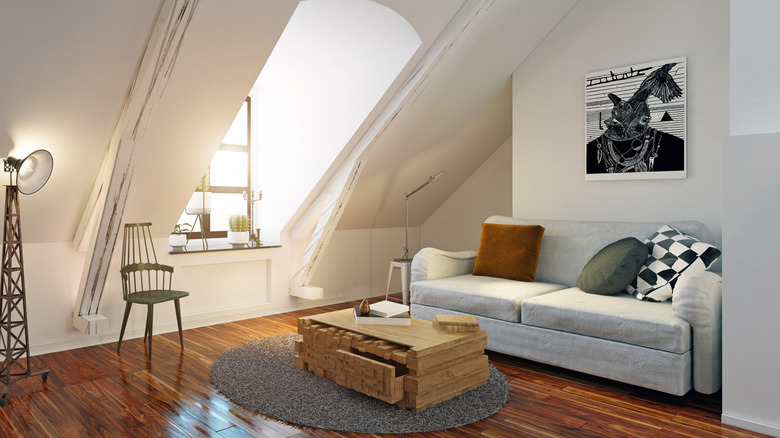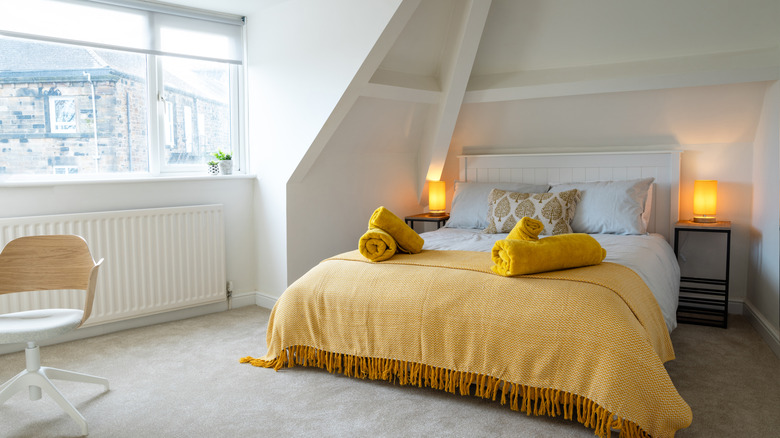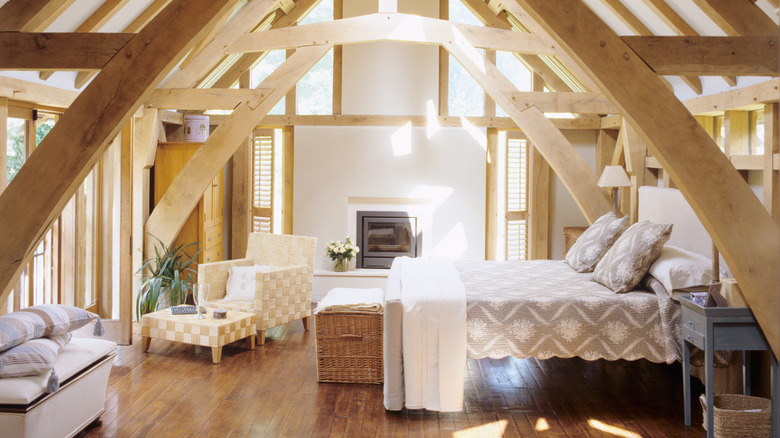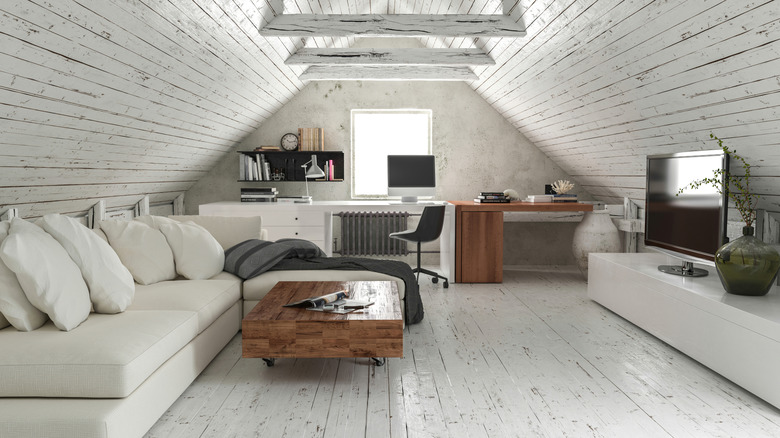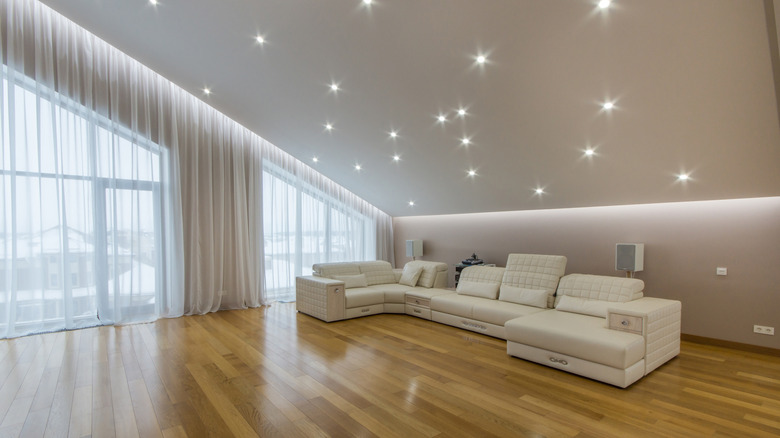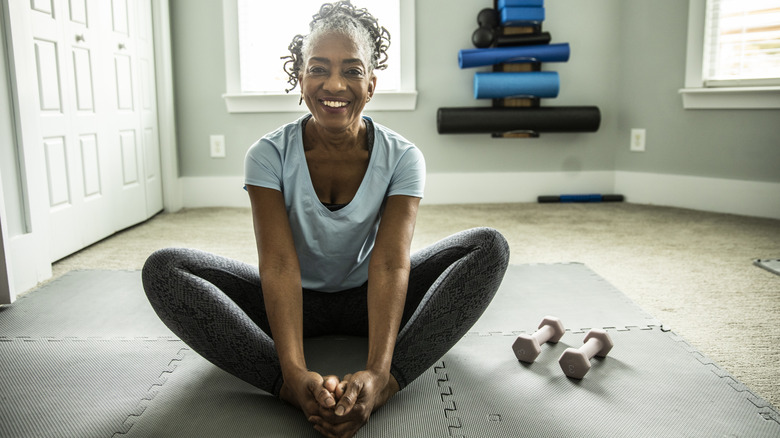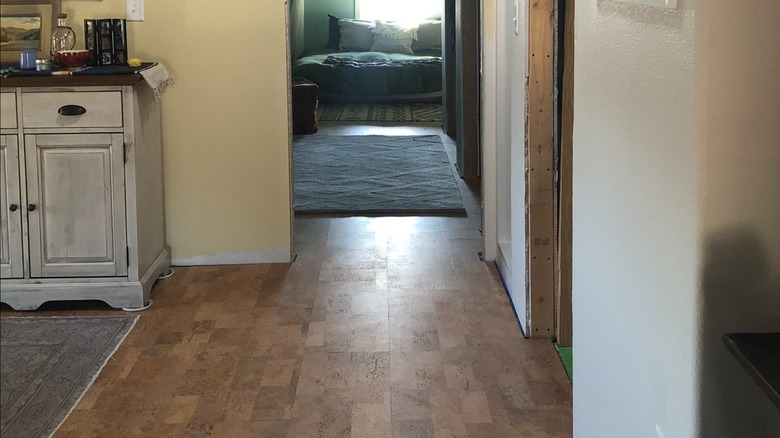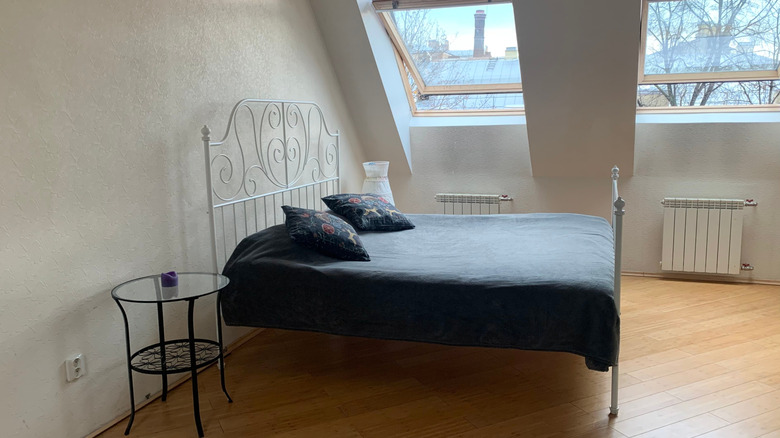Top Flooring Choices To Consider When Finishing Your Attic
We may receive a commission on purchases made from links.
There are lots of things to consider when you're finishing your attic. You must prioritize structural integrity, think about the best way to make the space easily accessible, ensure that you add sufficient insulation and ventilation, and make a plan for heating and cooling the space. One other important decision you'll need to make is which type of flooring you want to add to the space. While some floors aren't well suited to attic spaces (such as tiles, since the subfloor usually isn't rigid enough to prevent them from cracking), there are several possible flooring options to consider.
The best flooring choice for your attic will depend on your priorities (such as looks, ease of care, and soundproofing), as well as whether you are planning to DIY the installation or are going to leave it in the hands of a professional. In the sections that follow, we'll share a few of the top flooring choices for an attic, along with the characteristics that make them a good choice for such a space. We'll also highlight some installation tips and help you evaluate any potential downsides that could accompany each flooring choice.
Carpeting can minimize noise in an attic
There are several reasons to consider installing carpeting in a finished attic. First, if you're looking to make a warm and inviting space, you can't beat the plush feel of carpet combined with its soft colors. These characteristics can help counteract the otherwise cramped feel of the space due to the lower ceilings or exposed rafters.
Beyond the inviting touch it can provide, carpet can add insulation while also isolating sounds. It features a relatively dense construction of fibers. This allows it to retain heat much better than hard flooring options. Beyond keeping your toes from getting cold when walking around barefoot, carpet may even help you save energy on heating costs. These same dense fibers are also what helps carpet isolate sound better than other material. They'll absorb more of the noise to minimize what is heard in the rooms beneath the space.
Before installing carpets — or any other type of flooring in your attic — be sure to check local building regulations. Then, before installing the carpet, you'll need to install a subfloor, running perpendicular across the trusses. Once these preparation measures (that are necessary for any flooring installation) are complete, you can place the carpet tack strips, install the padding with a staple hammer-tacker, and then install the carpeting. If you'd prefer an easier option, you could also consider carpet tiles, like the Nexus Self-Adhesive Carpet Floor Tiles, over the prepared subfloor.
Consider hardwood flooring for a higher-end space
If you are looking to convert your attic into a higher-end living space, then you might consider hardwood flooring. Beyond the aesthetics it can add to the space, hardwood flooring offers additional benefits that could make it the right fit. First, these floors are known for their durability and longevity. While they might need to be refinished after several years of use, you won't need to worry about replacing them any time soon (or even at all). If you're looking to sell your home in the future, they are also more desirable to buyers and could deliver a better return on your investment. Plus, hardwood floors may also be a better choice if anyone in your home has allergies or asthma. Unlike some surface types, namely carpets, the smoother surface doesn't trap dust or other debris.
However, before you order hardwood flooring, there are a few things you'll want to keep in mind. First, it is not cheap. If you're already worried about how much it is going to cost to finish your attic, it won't be the best choice to help you keep the bottom line as low as possible. Additionally, hardwood floors are not moisture-resistant. If your attic is prone to higher humidity due to how your HVAC system is set up, they probably aren't the best choice for you. Hardwood floors also won't provide good insulation against sound. Insulation can help some. However, if there are bedrooms below the attic, you may want to think about when it is likely to be used and how it could affect anyone trying to sleep beneath it.
Vinyl offers some much-needed soundproofing
You shouldn't overlook vinyl flooring when you're thinking about finishing your attic. That's because one of its main benefits is its ability to minimize sound transfer due to how soft and flexible it is. This allows it to absorb noise better than materials like hardwood. In addition, some brands even offer acoustic backing on the planks to further minimize noise transfer to the floors beneath. However, not all vinyl is created equally — in fact, there are two different types of vinyl floors to choose from. When deciding whether vinyl sheets or planks are better, you'll want to weigh the pros and cons of each option.
Let's start with vinyl sheet flooring. It is an affordable option that may better fit your budget, especially if you're making other upgrades to your attic. Vinyl sheets are also thin. So, in an attic where there is already less space between the floor and the ceiling, they can help you make the most of what you've got. In addition, the sheets are also waterproof, so they could be a good fit if you are worried about moisture issues in your attic. However, the cheaper cost of vinyl sheeting does come with a trade-off. The patterns on these floors are not as attractive or realistic looking, so they could prevent you from achieving a more styled space.
Vinyl plank floors can also be a good fit for an attic. Also called luxury vinyl floors (LVF) or luxury vinyl planks (LVP), these floors can provide a higher-end look that vinyl sheeting can't. Plus, they can be much easier to install. While you can glue them down, they can also be installed as a floating floor. This installation option is particularly appealing for attic spaces. Beyond being easier to complete as a DIY project, the planks will also fare better when faced with more extreme temperature fluctuations. They'll be able to expand and contract with less risk of warping.
Laminate is a budget-friendly pick for an attic
Laminate is an appealing choice for attics for a variety of reasons. First, it is a more budget-friendly pick than several other options. If you're going to install it yourself, you could spend as little as $1 to $4 per square foot. Professional installation is a bit more, at $4 to $8 per square foot, but still significantly less expensive than many other options. As a comparison, hardwood flooring can cost between $6 and $18 per square foot when installed by a professional. Laminate is also a resilient material. It holds up well to temperature fluctuations and higher humidity levels that could be present in an attic. (There are some problems with installing laminate in a bathroom, though, because it is not fully waterproof). It is also known for its durability and ability to resist scratches, helping ensure the flooring remains in good condition for many years. In fact, it's a sturdier option than vinyl, which is often susceptible to dents due to its soft nature.
However, as with any flooring type, there are also some downsides to laminate to keep in mind. First, it doesn't offer the sound insulation properties of carpeting or vinyl flooring. It doesn't even perform as well as hardwood at minimizing sounds, so it might not be a good fit if anyone is trying to sleep beneath the attic when it is in use. It's also not as comfortable as vinyl or hardwood underfoot due to its sturdy fiberboard core. Whereas wood has a natural give to it, and vinyl has a more malleable surface (hence its proneness to dents), laminate feels hard under bare feet. This could make the room feel a little less comfortable, which could be a negative for a converted bedroom, playroom, or family room.
If you want something you can install yourself, go for interlocking foam tiles
Foam tiles are a popular pick for those looking to use their unfinished basement, and they could also be the right choice for your attic space. One of the most appealing aspects of these tiles is how easy they are to install — you can pop them in in minutes. The ProsourceFit Puzzle Foam Floor tiles and other similar products snap together to instantly give you a cushioned flooring surface. The foam material also offers good insulation, which can be a real benefit for an attic where the temperature is known to fluctuate more than in the other rooms. Foam tiles are also waterproof, easy to clean, and available in different colors to help you customize the look of your space. If something spills or damages one tile, you can easily swap it out for another one without needing to adjust the whole floor.
There are, however, some downsides of choosing foam tiles for your attic. First, if you are looking to convert it into a living space, the foam mats may look out of place with the other furniture pieces you add. They might be a better choice if you want to make the attic a yoga studio or exercise space. While relatively inexpensive and easy to install, foam mats also can't match the durability of most other flooring options. So, you may find that you need to replace them more frequently. The softer foam material can also become dented if heavier furniture is placed on top of it.
Consider cork if soundproofing is a priority
If you have bedrooms below your attic and want to be able to use the space while children or other family members are sleeping, you might want to think about installing cork flooring. Cork offers excellent sound absorption, so minimal noise will pass from the attic to the rooms below it. Cork can be installed as a floating floor, which can make for a simpler process if you're looking for a DIY project. It is also surprisingly durable and long-lasting. With proper maintenance, a cork floor can last for several decades. If you're looking to decrease your environmental footprint, you may also appreciate that it is a sustainable flooring material.
Before deciding whether cork flooring is the right choice for your home, or specifically for your attic, there are a few things you'll want to keep in mind. First, you'll need to periodically re-coat the flooring to keep it in good condition and to extend its lifespan. This should be done every three to 10 years using a water-based polyurethane coating, such as the Minwax One Coat Polyurethane. However, it can be a bit challenging to determine when the finish has started wearing too thin. And, if you misjudge when a re-coating is needed, it could be too late, and the floor could become damaged more easily because of its susceptibility to scratches and dings. If you're planning to install a skylight or a large window in your attic, cork also might not be the best flooring material since it is prone to fading when exposed to direct sunlight.
Bamboo flooring is an attractive and sustainable option
If you're looking for a flooring material that is as attractive as hardwood but doesn't come with such a steep price tag, then bamboo flooring may be the ideal solution for your attic. First, it is a pest-resistant material, so if you're worried about carpenter ants or termites getting into your attic, it could provide you with some peace of mind. While it mimics the look of hardwood in many ways, bamboo is really a grass. While it's not 100% pest-proof, many insects and bugs won't be as happy to dine on it as they would hardwood. Bamboo is also an extremely durable material — it is much harder than many types of hardwood flooring. Moreover, bamboo plants grow so quickly that they're considered sustainable materials.
However, there are a few downsides to consider. Because it is hardwood, it is susceptible to damage from moisture. So if your attic has high humidity levels, you might want to consider an alternative. While installation is not overly complicated, there are some bamboo flooring installation mistakes that you'll also want to be careful to avoid. For example, opt for a floating installation method. Not only is this easier as a DIY project than trying to glue down the boards, but it is also better suited for an attic. If the boards expand and contract with hot or cold temperatures, there will be less concern about them warping. It will also be essential to use the right type of underlayment for the floors, especially if you want to provide better insulation and sound absorption. The 3-in-1 underlayments, like the AMERIQUE Premium Flooring Underlayment, are best for bamboo floors.
